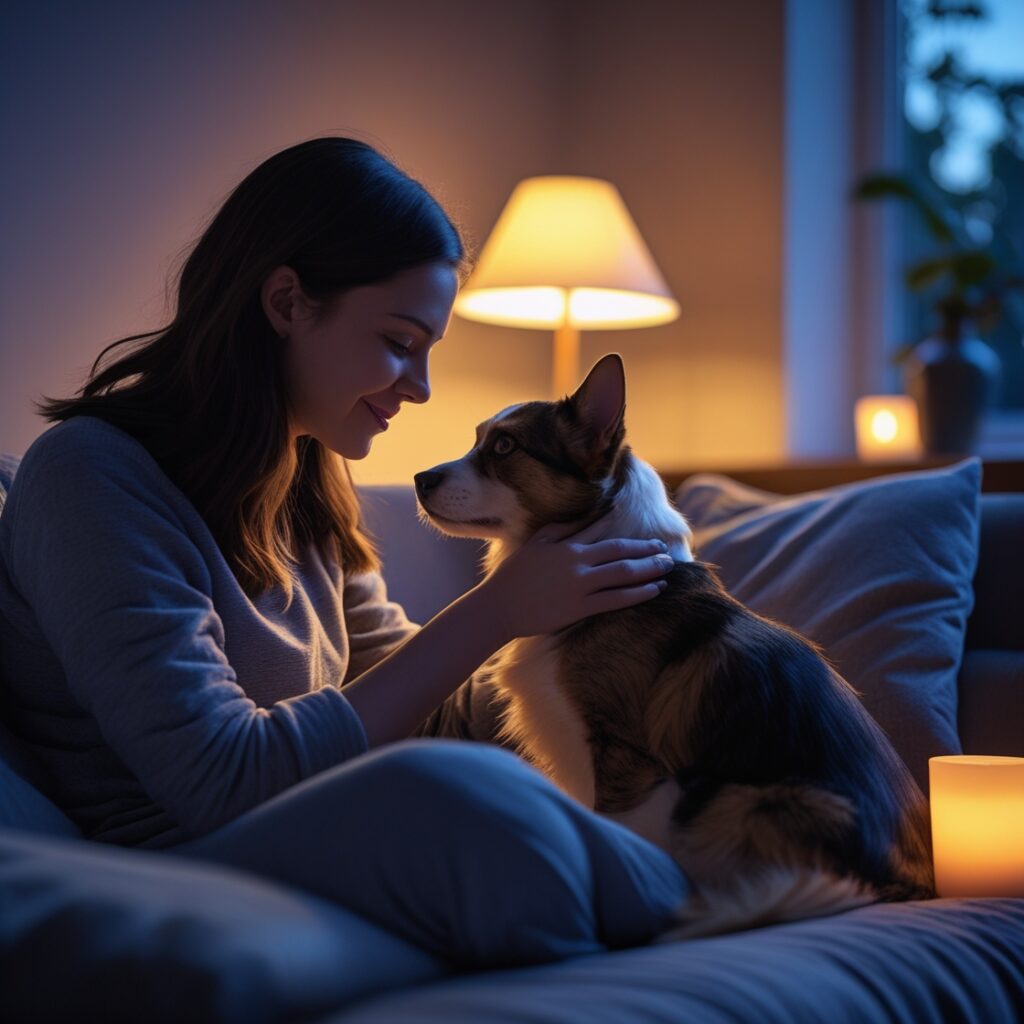Have you ever felt the soothing presence of your furry friend during your meditation sessions? 🐾 You’re not alone! Many pet owners have noticed their pets joining in on their mindfulness practices, creating a unique bond and shared moment of tranquility. But can pets actually meditate with you?
The idea of pet meditation might sound unusual, but it’s gaining traction among animal lovers and wellness enthusiasts alike. Imagine a world where your stressed-out Siamese or anxious Alaskan Malamute could find inner peace alongside you. 🧘♀️🐱🐶 It’s not just a pipe dream – it’s a growing trend that’s transforming the way we interact with our beloved companions.

In this blog post, we’ll dive deep into the fascinating world of pet-calming rituals and explore how you can create a zen-like atmosphere for both you and your furry friend. From understanding the basics of pet meditation to overcoming challenges and enhancing your bond, we’ll guide you through every step of this pawsome journey. So, grab your yoga mat, call over your four-legged friend, and let’s embark on this enlightening adventure together!
Understanding Pet Meditation
Defining meditation for pets
Pet meditation is a practice that adapts human meditation techniques to suit animals, focusing on creating a calm and relaxed state for our furry companions. Unlike human meditation, which often involves conscious effort, pet meditation is more about guiding animals into a state of peaceful awareness through environmental cues and gentle interactions.
Benefits of pet meditation
Pet meditation offers numerous advantages for both animals and their owners:
- Stress reduction
- Improved behavior
- Enhanced bond with owners
- Better sleep quality
- Increased overall well-being
| Benefit | For Pets | For Owners |
|---|---|---|
| Stress Relief | Reduced anxiety and fear | Lower blood pressure |
| Bonding | Increased trust in humans | Deeper connection with pets |
| Health | Improved immune function | Decreased risk of stress-related illnesses |
Signs of relaxation in animals
Recognizing when your pet is entering a meditative state is crucial for successful pet meditation. Look for these indicators:
- Slowed breathing rate
- Relaxed muscles and posture
- Half-closed or softly focused eyes
- Reduced reactivity to external stimuli
- Calm, quiet behavior
Different species may display unique signs of relaxation. For example, cats often purr and knead when content, while dogs might lie on their side with loose limbs. As you practice pet meditation regularly, you’ll become more attuned to your pet’s individual relaxation cues, allowing you to create a more effective calming ritual. With this understanding of pet meditation, we can now explore how to create the ideal environment for these calming practices.
Creating a Pet-Friendly Meditation Space
A. Choosing the right location
When creating a pet-friendly meditation space, selecting the right location is crucial. Look for a quiet area in your home where both you and your pet feel comfortable. Consider the following factors:
- Natural light: Choose a spot with soft, natural light to create a calming atmosphere.
- Temperature: Ensure the area is neither too hot nor too cold for both you and your pet.
- Traffic: Avoid high-traffic areas that might disturb your meditation practice.
Here’s a comparison of potential meditation locations:
| Location | Pros | Cons |
|---|---|---|
| Living room | Spacious, familiar to pet | Potential distractions |
| Bedroom | Quiet, comfortable | Limited space |
| Outdoor patio | Fresh air, nature sounds | Weather-dependent |
| Dedicated room | Customizable, minimal distractions | Requires extra space |
B. Setting up comfortable seating
Comfortable seating is essential for both you and your pet during meditation. Consider these options:
- For humans:
- Meditation cushion or zafu
- Yoga mat
- Comfortable chair with back support
- For pets:
- Soft pet bed or cushion
- Cozy blanket
- Pet-sized yoga mat
C. Minimizing distractions
To create a focused environment for pet meditation, minimize distractions by:
- Using white noise machines or calming music
- Closing curtains or blinds to reduce visual stimuli
- Turning off electronic devices
- Informing family members to avoid interruptions
D. Incorporating pet-friendly elements
Make the meditation space inviting for your pet by adding:
- Familiar toys or comfort objects
- Pet-safe plants like catnip or wheatgrass
- A water bowl for hydration
- Pheromone diffusers for added relaxation
Remember to keep the space clean and clutter-free to maintain a serene atmosphere for both you and your pet. With these elements in place, you’ll have created a welcoming environment for shared meditation experiences.
Techniques for Pet-Calming Rituals
Guided breathing exercises
Incorporating guided breathing exercises into your pet’s calming routine can significantly reduce their stress levels. Start by demonstrating slow, deep breaths for your pet to observe. Many animals naturally synchronize their breathing with their owners, promoting a sense of calm.

Here’s a simple technique to try:
- Sit comfortably with your pet
- Take slow, audible breaths
- Gently place your hand on your pet’s chest
- Encourage them to match your breathing rhythm
Gentle touch and massage
Touch is a powerful tool for calming pets. A gentle massage can help relax tense muscles and promote overall well-being. Different pets may prefer various types of touch:
| Pet Type | Preferred Touch Areas |
|---|---|
| Dogs | Ears, neck, shoulders |
| Cats | Base of tail, chin |
| Rabbits | Forehead, cheeks |
Soothing music and sounds
Calming music or nature sounds can create a peaceful environment for your pet. Many animals respond positively to classical music or specially composed pet relaxation tracks. Start with low volume and observe your pet’s reaction, adjusting as needed.
Aromatherapy for pets
Certain scents can have a calming effect on pets, but it’s crucial to use pet-safe essential oils and diffusers. Popular calming scents include:
- Lavender
- Chamomile
- Valerian
Always consult with a veterinarian before introducing new scents to your pet’s environment.
Visual cues and focal points
Creating a visual focal point can help your pet concentrate during meditation sessions. This could be a slowly moving object, like a lava lamp, or a stationary item that captures their attention. Ensure the focal point is at your pet’s eye level for maximum effectiveness.
Now that we’ve explored various techniques for pet-calming rituals, let’s move on to how you can introduce your pet to the practice of meditation.
Introducing Your Pet to Meditation
Starting with short sessions
Begin your pet’s meditation journey with brief, manageable sessions. Start with just 2-3 minutes and gradually increase the duration as your pet becomes more comfortable. Short sessions help prevent boredom and maintain your pet’s interest. Here’s a suggested progression:
| Week | Session Duration |
|---|---|
| 1-2 | 2-3 minutes |
| 3-4 | 5-7 minutes |
| 5-6 | 10-15 minutes |
Using positive reinforcement
Encourage your pet’s participation through positive reinforcement:
- Offer treats or praise for calm behavior
- Use gentle petting or scratches as rewards
- Provide a favorite toy after the session
Establishing a routine
Consistency is key when introducing your pet to meditation. Create a regular schedule that aligns with your pet’s natural rhythms:
- Choose a quiet time of day
- Meditate in the same location
- Use familiar cues (e.g., specific music or scents)
- Practice at the same time daily
Adapting to your pet’s preferences
Every pet is unique, so tailor your approach to suit their individual needs:
- Observe your pet’s reactions to different techniques
- Experiment with various positions (sitting, lying down)
- Adjust the environment (lighting, temperature) for comfort
- Be flexible and patient as you discover what works best
Remember, the goal is to create a calming experience that both you and your pet can enjoy together. By starting small, using positive reinforcement, establishing a routine, and adapting to your pet’s preferences, you’ll be well on your way to successful pet meditation sessions.
Species-Specific Meditation Approaches
Meditating with dogs
Dogs are naturally attuned to their owners’ emotions, making them excellent meditation partners. Here are some dog-specific meditation techniques:
- Breath-syncing: Encourage your dog to lie next to you and synchronize your breathing with theirs.
- Gentle touch meditation: Use slow, calming strokes while focusing on your breath.
- Walking meditation: Practice mindfulness during your daily walks.
| Technique | Description | Benefits |
|---|---|---|
| Breath-syncing | Match your breath to your dog’s | Deepens connection, promotes relaxation |
| Gentle touch | Slow, mindful petting | Reduces anxiety, enhances bonding |
| Walking meditation | Mindful awareness during walks | Improves focus, provides exercise |
Cat-friendly meditation practices
Cats are independent creatures, but they can still participate in calming rituals:
- Purr meditation: Focus on your cat’s purring as a natural sound meditation.
- Shared sunbathing: Join your cat in a sunny spot for a warm, relaxing meditation.
- Feather wand mindfulness: Use a feather toy to guide your cat’s attention gently.
Calming techniques for small pets
For smaller pets like rabbits, guinea pigs, or hamsters:
- Create a quiet, enclosed space for meditation sessions.
- Use soft music or white noise to mask startling sounds.
- Practice slow, deliberate movements to avoid frightening your pet.
Meditation for exotic pets
Exotic pets like reptiles or birds may require unique approaches:
- Observational meditation: Focus on your pet’s natural behaviors.
- Habitat-based meditation: Incorporate elements of your pet’s environment into your practice.
Remember, each animal is unique. Observe your pet’s reactions and adjust your approach accordingly. With patience and consistency, you can develop a meditation routine that benefits both you and your pet.
Overcoming Challenges in Pet Meditation
Dealing with restlessness
When introducing pets to meditation, restlessness is a common challenge. To address this:
- Start with short sessions (2-5 minutes) and gradually increase duration
- Use gentle physical touch or massage to soothe your pet
- Incorporate calming scents like lavender or chamomile
- Practice during your pet’s naturally calm periods (e.g., after meals)
Managing multiple pets
Meditating with multiple pets requires extra planning:
| Strategy | Description |
|---|---|
| Separate sessions | Meditate with each pet individually |
| Designated spaces | Assign specific spots for each pet during group sessions |
| Hierarchy-based approach | Start with the calmest pet and gradually introduce others |
Addressing noise and disruptions
External stimuli can disrupt pet meditation. Try these techniques:
- Use white noise or calming music to mask external sounds
- Choose a quiet room away from windows and doors
- Consider using blackout curtains to reduce visual distractions
- Practice at times when your environment is naturally quieter
Adjusting expectations
Remember that pet meditation is a journey:
- Celebrate small victories, like a few moments of stillness
- Understand that progress may be slow and non-linear
- Adapt your approach based on your pet’s unique personality and needs
- Focus on the bonding experience rather than perfect meditation form
By addressing these challenges with patience and creativity, you can create a rewarding meditation practice with your pet. As you overcome obstacles together, you’ll strengthen your connection and enjoy the calming benefits of shared mindfulness.
Enhancing the Human-Pet Bond Through Meditation
Strengthening emotional connection
Meditating with your pet can significantly enhance your emotional bond. As you practice mindfulness together, you create a shared experience that fosters trust and understanding. This quiet time allows you to attune to your pet’s emotions and needs, strengthening your intuitive connection.
Improving communication
Through regular meditation sessions, you and your pet can develop a unique form of non-verbal communication. Here’s how meditation improves pet-human communication:
- Increased awareness of subtle cues
- Enhanced ability to read body language
- Development of a calming presence
- Improved patience and listening skills
Sharing quality time
Meditation offers a unique opportunity to spend focused, uninterrupted time with your pet. This dedicated attention can:
| Benefit | For Pet | For Human |
|---|---|---|
| Reduce anxiety | Feels secure and valued | Alleviates guilt of busy schedules |
| Increase trust | Strengthens bond with owner | Deepens understanding of pet’s needs |
| Promote relaxation | Learns to associate owner with calmness | Enhances overall well-being |
Mutual stress reduction
Engaging in meditation with your pet creates a synergistic effect on stress reduction. As you both enter a state of relaxation, you’ll notice:
- Decreased cortisol levels in both you and your pet
- Lowered heart rates and blood pressure
- Improved sleep quality for both
- Enhanced overall mood and behavior
By incorporating your pet into your meditation practice, you’re not only improving your own well-being but also nurturing a deeper, more harmonious relationship with your furry companion. This shared experience of tranquility and mindfulness can lead to long-lasting positive effects on both your lives.
Conclusion
Meditation with your pet can be a rewarding experience that deepens your bond and promotes calmness for both of you. By creating a pet-friendly meditation space, introducing calming rituals, and tailoring your approach to your pet’s species, you can overcome common challenges and enjoy the benefits of shared mindfulness.

Remember, the key to successful pet meditation lies in patience, consistency, and understanding your pet’s unique needs. As you embark on this journey together, you’ll likely discover new ways to communicate and connect with your furry companion. So why not give it a try? Your next meditation session could be the start of a beautiful, peaceful ritual for both you and your pet.



